Medieval / Renaissance Great Pipes
The Medieval Great Pipe is a single drone, conical bore bagpipe with a warm and present sound. During the Renaissnance a second drone was added and expanded the complexity of the instruments sound. The timbre and visual presence of the bagpipe is similar to other bagpipes found on the Atlantic coast of Europe such as the Spanish Gaita, the Breton Vueze, and the Great Highland bagpipe to name a few.
Each drone is made with three sections and when fully extended plays in ‘A’ and ‘E’. If the drones are pushed down and shortened they can produce ‘B’ and ‘F’. This is done with no additional manipulation to the reed. If both middle sections of the drones are removed, connecting the top and bottom joints, they will play up a forth and produce ‘D’ and ‘A’. A common configuration for the pipes is to play the Bass in A with the Baritone in E. A more contemoary sound can be derived by playing the Bass in ‘A’ and removing the middle section of the Tenor to play in ‘A’ and octave above the bass.
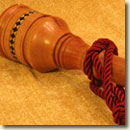

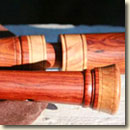
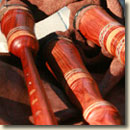


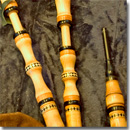
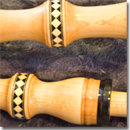

Dear RK,
I’d like to know if you can make medieval bagpipes like those used by Corvus Corax. http://www.corvuscorax.de.
If so, how long is the manufacturing period?
What is a rough estimate of cost and pre-payment?
Regards,
Mike
I could make something similar but not quite as exaggerated. The equipment I have wouldn’t be able to make the 8inch diameter trumpet flares. Are familiar with Stefan Fischer http://www.sackpfeifenmacher.de/fischer/index.htm ? I could probably mimic his style more easily. In fact it was playing his pipes that inspired me to start making my own.
Hello,
I am interested in a medieval bagpipe. Like the above poster, I am inspired by bands like Corvus Corax and In Extremo. They do have large flares. I also visited Fischer’s site and found a style that I liked and am wondering if you can do something like it.
Mittelalterliche Sackpfeife ‘1’ in ‘G’, ein Bassbordun on this page:
http://www.sackpfeifenmacher.de/fischer/prod.htm?&kat=12
Thanks,
Adam
Hi Adam,
Yes I can place a trumpet style drone termination on the pipes. My “standard” way of making them is to use a chambered end because I find that the drones have a better “mix” with the chanter. Now historically speaking I don’t think any of the actual medieval pipes would have used this but you do see this style of drone termination from the renaissance onward. For all of my pipes I try to work with the buyer and make exactly the instrument they are looking for. Please contact me any time if you want more details.
-Richard
Richard,
I think I understand what you are saying about the chambering. Would it be possible for aesthetic purposes to creat the chamber so that it is large than normal to give a similar look as those 8″ flares.
I really love the craftsmanship you have shown in your pictures. As I imagine creative ways of “spicing” up an instrument, i cant help but enjoy the simple, tasteful ways you have adorned your pipes!
Hi Adam,
Thanks for the wonderful remarks!
You have the right idea about the large flared end but you wouldn’t need to make the drone chamber any bigger — you would just leave more wood on the outside of that piece of wood and turn the inside dimensions the same as usual. That said, the whole point of a large flared end is to give the instrument that real bright “trumpet” sound. In fact, if you have just one drone you don’t necessarily want it to blend well with the chanter, it might be better if it is loud and brash so that you can hear it. Do you play highland pipes? Ever shut of both of your tenors? Not much drone going on from just the bass. Putting that flare on the end of the drone helps to increase its volume and also makes the timber brighter. My personal preference is to make a compromise between the two. I make a large chamber but the build of the chamber is such that there is still a flare effect. The wood I use for the drone termination is 3″ (all the sets pictured on my site are that size) If you want to 4″ there would be no problem but 5″ and greater would require either some pricey cuts of wood or gluing two thinner pieces together – not a problem to build but there would be more time involved to make it happen.
I hope that answers your question!
-Richard
I have just received a set of Jens Guntzel medieval bagpipes (I play GHB bagpipes) I hope you a fimilar with his pipes. Anyway I have a question. On his chanter there is a small hole for the reed, I think. The hole is to small for the reed. I was wondering if I need to make the hole larger or does the top of the chanter come apart so that the reed fits inside the chanter instead of on top? Jens speaks German and I don’t so I am hopeing you can answere my queston. Drogo recommends you but now I can’t get in touch with him. Thanks
It sounds like he may not have bored the counter-sink hole enough. the read should fit into the top of the chanter by about a quarter on an inch.